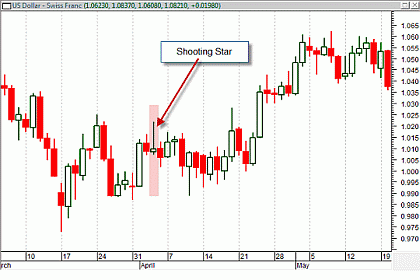In a prior article, we talked about hammers as a bullish continuation or reversal pattern. There is also a mirror image of this pattern called a shooting star. It is what it sounds like; shooting stars are bearish reversal or bearish continuation patterns. Like hammers, they tell a story of shifting investor sentiment and appear in just about any market. A shooting star is useful not only as a timing signal for short entries, but as a warning to long positions. If you are long a pair and a shooting star appears, additional risk coverage is a great idea.
A shooting star consists of a small body with very little or no lower shadow and an upper shadow that is at least two times longer and preferably three or more times longer than the candle body. When these candles appear in a downtrend, they are a good signal that the temporary appearance of bullish momentum (signified by the tall upper shadow) has been beaten back by the bears and the market is going to continue to the downside. When this candle appears during an uptrend, it is a strong indication of weakening bullish momentum and long positions are in danger. The pattern is reasonably effective across different time frames, but trading costs can make a negative impact for very short-term traders.
In the chart below, you can see how a shooting star on 4/3 indicated a weakening rally, which continued until the breakout almost two weeks later on the USD/CHF. This is a good example of how a shooting star could be used as a warning to new long positions trying to take advantage of the new rally that started in March.
USD/CHF Daily Chart
I tested this candlestick's "predictiveness" using my standard methodology. I set a 25-pip trailing stop loss on short positions that would be "entered" at the open of the following candle's open. If the position was profitable, I considered that a successful signal. If the position were stopped out with a loss, I considered that a negative signal. This is a mechanical test, so it will inevitably be somewhat optimized, but this is a great way to establish a baseline for what to expect in the live market. I should also point out that I did not qualify or "confirm" the signal in any other way. Traders may be able to improve the effectiveness of such a pattern by integrating support and resistance or other qualifying signals.
Pairs tested in order of effectiveness:
USD/CHF
GBP/USD
AUD/USD
USD/JPY
EUR/USD
USD/CAD
NZD/USD
GBP/JPY
Testing Period
Daily candles 01/01/2000 - 08/08/2008
Percentage of Winners (profitable trades)
50%
Ratio of Average Gain:Average Loss
2.26:1
Expectancy
+63%
Summary:
Like hammers, shooting stars are one of the most successful patterns I have tested. Anecdotally, this is one of those signals I see a lot of other traders using for the same reason. The one drawback to this pattern is that it does not occur as frequently as other, more common signals like engulfing candles.
By John Jagerson, of PFXGlobal.com and LearningMarkets.com.




















